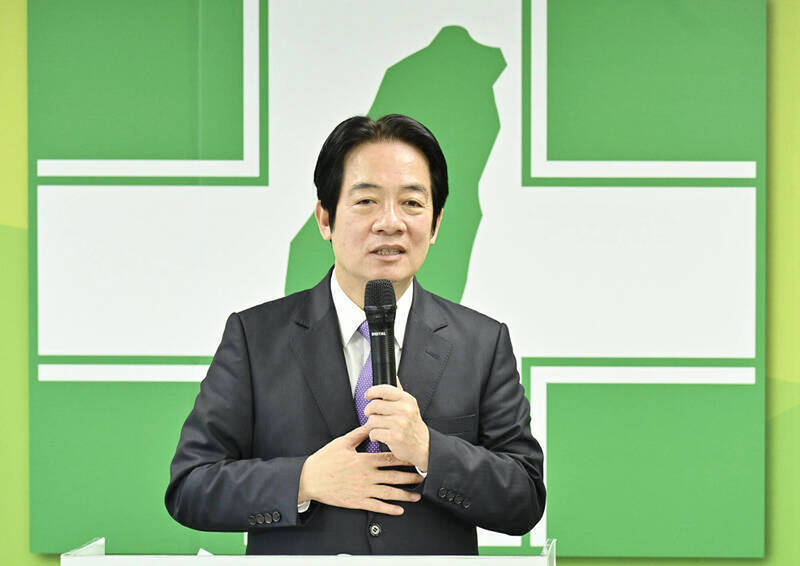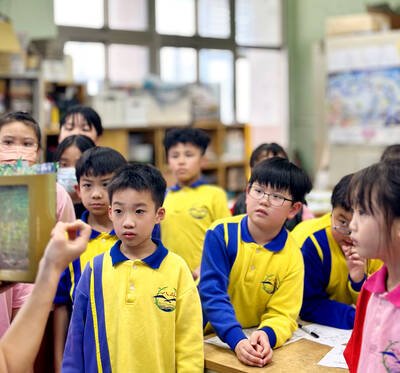The latest Formosa poll released at the end of last month shows confidence in President William Lai (賴清德) plunged 8.1 percent, while satisfaction with the Lai administration fared worse with a drop of 8.5 percent. Those lacking confidence in Lai jumped by 6 percent and dissatisfaction in his administration spiked up 6.7 percent.
Confidence in Lai is still strong at 48.6 percent, compared to 43 percent lacking confidence — but this is his worst result overall since he took office. For the first time, dissatisfaction with his administration surpassed satisfaction, 47.3 to 47.1 percent. Though statistically a tie, for most of his administration his satisfaction was 10 points or higher above dissatisfaction — with a few months above 20 points — so this is still a significant result.
The president’s Democratic Progressive Party (DPP) also fared poorly. The percentage of those feeling positive about the DPP was down by 8.9 percent and those with a negative impression of the party surged by 8 percent, a cumulative swing of 16.9 percent, putting the party underwater by 5.1 percent compared to a net positive of 11.8 percent at the end of March.

Photo: TT file photo
The big winner from this swing in support was the Taiwan People’s Party (TPP), which saw an increase of 6.3 percent of respondents viewing the party positively, reaching 31.5 percent. That is the best result since July last year at 31.6 percent, the month before party founder Ko Wen-je (柯文哲) was engulfed in several alleged scandals and prosecutors detained him on charges of alleged corruption. Negative impressions of the party remained higher than July last year by 4.7 percent, however.
The Chinese Nationalist Party (KMT) saw their polling rise by 2 percent. Combined, the TPP and KMT saw their positives raised by 8.3 percent, roughly in line with the drop in support for the DPP.
Should the DPP be drowning their sorrows in whisky while the TPP pops Champagne corks?
Not yet.
FORMOSA POLLING
Formosa polling is, in my opinion, the most reliable local pollster. Every month for years they have asked a range of key questions, using the same format, allowing for consistent analysis over time. They also provide a very detailed breakdown of their results, allowing anyone to dig into the data to come to their own conclusions.
Their polling is also usually stable, with large shifts in opinion usually only occurring following dramatic news events that would be expected to influence public opinion. This is crucial and sets them apart from some local pollsters whose results veer erratically from month to month for no discernible reason, but happen to produce excellent fodder for headline writers and publicity for their polls.
Formosa’s chairman, Wu Tzu-chia (吳子嘉), is not as stable and professional as his polling outfit, frequently getting into legal trouble for defamation. The latest judgment handed down to him the other day was for calling Ko Wen-je “rotten goods,” a “son of a bitch,” a “dog,” and said “f**k your mother” about Ko on his Youtube channel last year.
For that, he was sentenced to 30 days’ detention, commutable to a fine of NT$1,000 a day. He pleaded guilty and can still appeal.
Also, despite the excellent data his company produces, his analysis is not very good.
COMPLICATED RESULTS
The last two months have been unusual. December’s results showed a sharp negative swing against the KMT, with negative feelings toward the party skyrocketing by 12.4 percent and a drop in positive impressions of 7.2 percent. This had a clear explanation: The legislature was in chaos.
However, after a calm January and February, the results for March and last month were highly volatile. At the end of March, the DPP was up by 9.1 percent and Lai, his administration and especially the cabinet’s ratings were also significantly higher while the KMT and TPP slid by a few percentage points. Then the tide turned against the DPP last month.
While headline writers love dramatic swings in public opinion polls, without context this can be misleading. Polls cannot be viewed as stand-alone results, but need to be analyzed over time.
Normally, it is easy to determine the reasons why Formosa polling shows significant shifts, but the results from March and last month are more complicated.
It gets even more confusing when the results are broken down, especially by age in the DPP and TPP. Some volatility is expected in these numbers as out of the over 1000 people polled in Formosa polls, only about 150-220 are in each age demographic. A smaller number of people can skew the results. Yet, the numbers usually broadly mirror the aggregate results and historically have been generally stable over time.
In the last three months, double-digit swings in multiple age demographics have appeared in both the DPP and TPP, with the demographics not lining up very well with the patterns over the last few years.
One constant has been that the TPP’s support is strong among those under 40, though the numbers fluctuate significantly from month to month. Curiously, their support among those 50-59 has dropped and among those 40-49 it has plunged between the election and early this year, while support from those aged over 60 have increased by about 50 percent.
Older voters did not like (and likely did not trust) Ko, but perhaps they are warming to new party Chairman Huang Kuo-chang (黃國昌).
DUE FOR REALIGNMENT?
Why the spike in support for the DPP in March and the plunge last month?
Some possibilities are clear. During March, the pan-green recall campaigns had strong momentum while allegations and investigations were rising against pan-blue recall campaigns over registering dead voters using KMT membership rolls and by local KMT officials allegedly intimidating pan-green campaigners.
US President Donald Trump last month launched “liberation day,” and Taiwan was high on the list for punitive tariffs. Various recent polls have shown a plunge in Taiwanese confidence in the US, including as a strong trading ally and military supporter.
This added to a strong sense of unease and insecurity. Taiwanese are acutely aware of the precarious situation militarily, and that Taiwan’s economy is heavily export-dependent. Virtually everyone has a family member involved in the export business or is reliant on supplying exporters and their employees with services and products. Taiwan has grown rich on the American market and kept safe through American military might.
This has left Taiwan with few cards to play, no matter the ruling party. There are deep-seated worries in the Taiwanese psyche about being abandoned by the US. It has happened before.
When feeling nervous and powerless about forces out of Taiwan’s control, it is a natural reaction to blame the government.
But this does not explain why there was a bigger shift to the TPP than the KMT last month. To paint the KMT overall as “anti-American” is inaccurate, but there is a wing of the party that is consistently skeptical and sometimes hostile to the US. This should have been that wing’s time to shine and say, “I told you so,” but the voters are not buying it.
With political conflict at home and economic turmoil on the world stage while China ratchets up the pressure on Taiwan there is considerable uncertainty. The recent poll results are a reflection of the current volatile situation.
However, should the pressures on Taiwan intensify economically and/or militarily, it could cause fractures and realignments in the political landscape.
It is too soon to make a definitive call either way, and much depends on external factors.
The last big political realignment took place between 2014 and 2016.
Are we due for another?
Donovan’s Deep Dives is a regular column by Courtney Donovan Smith (石東文) who writes in-depth analysis on everything about Taiwan’s political scene and geopolitics. Donovan is also the central Taiwan correspondent at ICRT FM100 Radio News, co-publisher of Compass Magazine, co-founder Taiwan Report (report.tw) and former chair of the Taichung American Chamber of Commerce. Follow him on X: @donovan_smith.

May 26 to June 1 When the Qing Dynasty first took control over many parts of Taiwan in 1684, it roughly continued the Kingdom of Tungning’s administrative borders (see below), setting up one prefecture and three counties. The actual area of control covered today’s Chiayi, Tainan and Kaohsiung. The administrative center was in Taiwan Prefecture, in today’s Tainan. But as Han settlement expanded and due to rebellions and other international incidents, the administrative units became more complex. By the time Taiwan became a province of the Qing in 1887, there were three prefectures, eleven counties, three subprefectures and one directly-administered prefecture, with

It’s an enormous dome of colorful glass, something between the Sistine Chapel and a Marc Chagall fresco. And yet, it’s just a subway station. Formosa Boulevard is the heart of Kaohsiung’s mass transit system. In metro terms, it’s modest: the only transfer station in a network with just two lines. But it’s a landmark nonetheless: a civic space that serves as much more than a point of transit. On a hot Sunday, the corridors and vast halls are filled with a market selling everything from second-hand clothes to toys and house decorations. It’s just one of the many events the station hosts,

Through art and storytelling, La Benida Hui empowers children to become environmental heroes, using everything from SpongeBob to microorganisms to reimagine their relationship with nature. “I tell the students that they have superpowers. It needs to be emphasized that their choices can make a difference,” says Hui, an environmental artist and education specialist. For her second year as Badou Elementary’s artist in residence, Hui leads creative lessons on environmental protection, where students reflect on their relationship with nature and transform beach waste into artworks. Standing in lush green hills overlooking the ocean with land extending into the intertidal zone, the school in Keelung

Taiwan Power Co (Taipower, 台電) and the New Taipei City Government in May last year agreed to allow the activation of a spent fuel storage facility for the Jinshan Nuclear Power Plant in Shihmen District (石門). The deal ended eleven years of legal wrangling. According to the Taipower announcement, the city government engaged in repeated delays, failing to approve water and soil conservation plans. Taipower said at the time that plans for another dry storage facility for the Guosheng Nuclear Power Plant in New Taipei City’s Wanli District (萬里) remained stuck in legal limbo. Later that year an agreement was reached